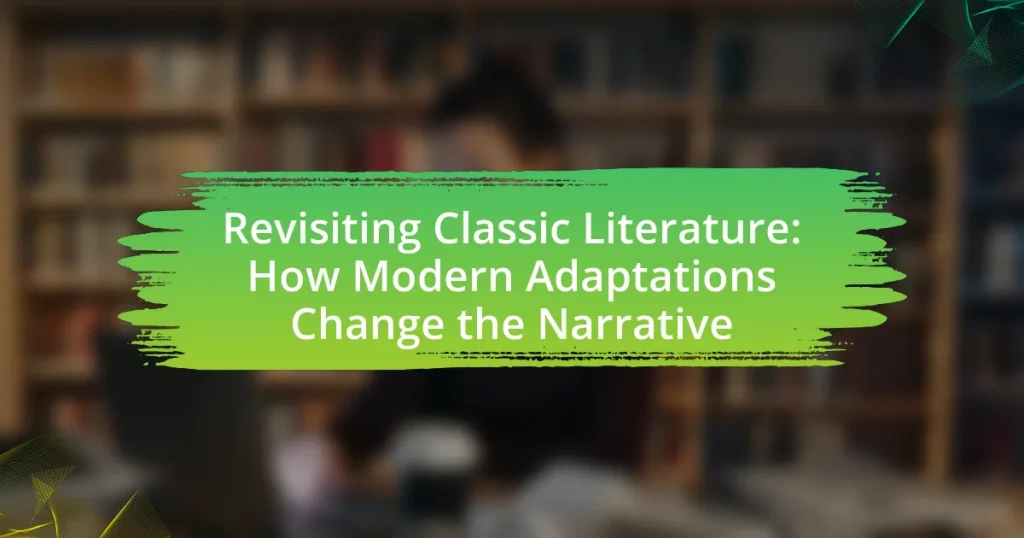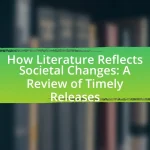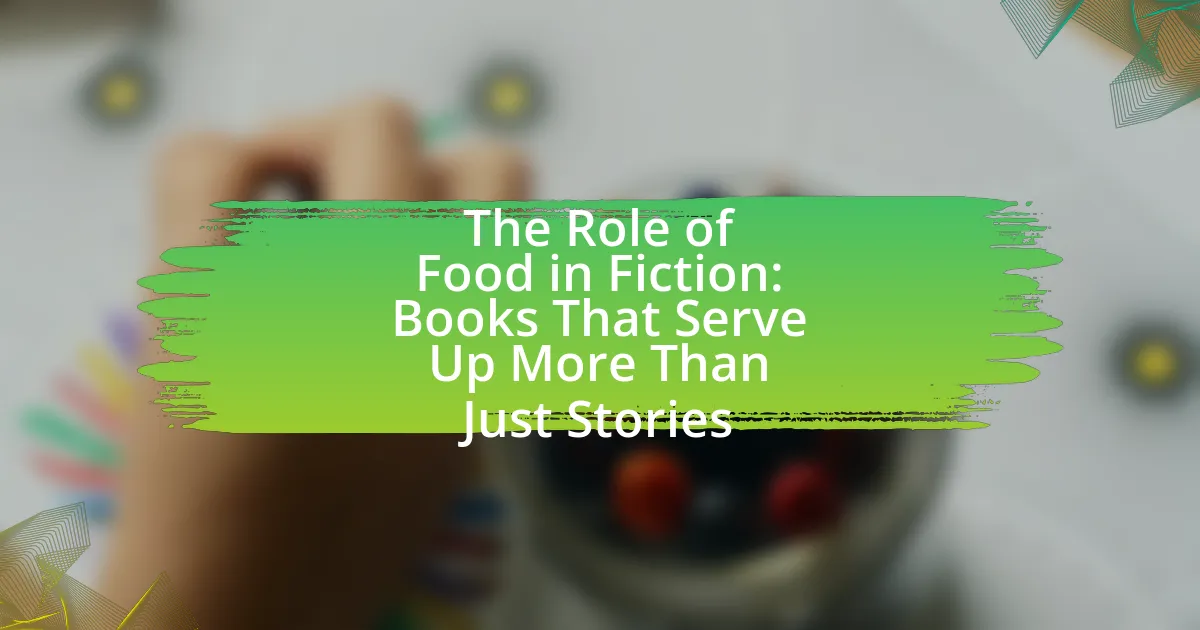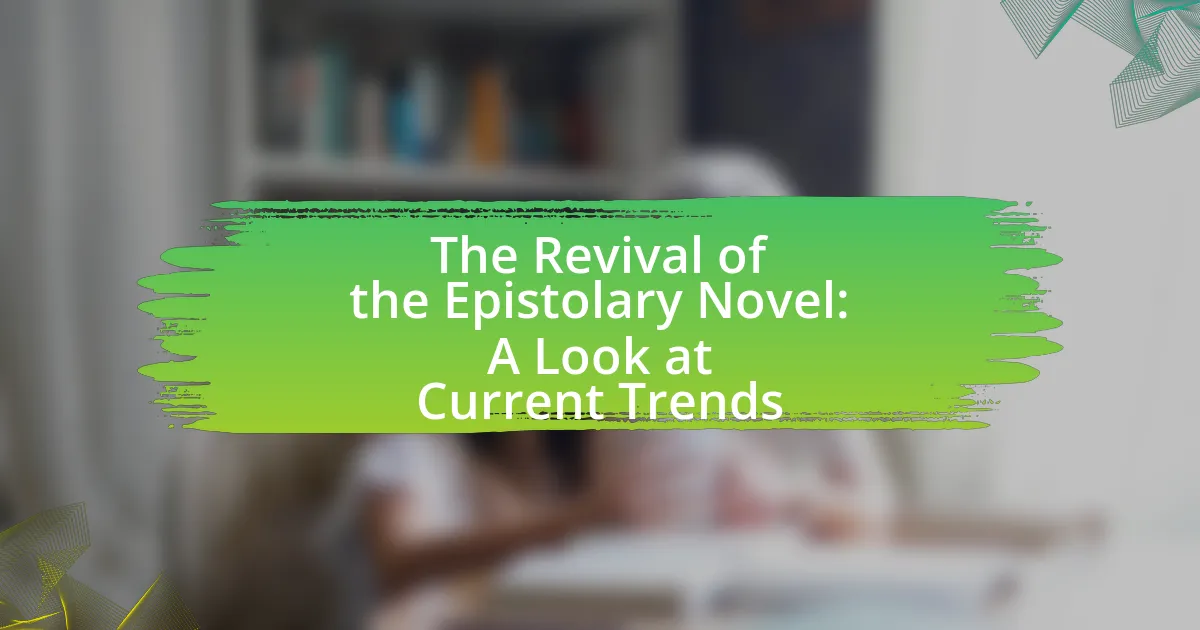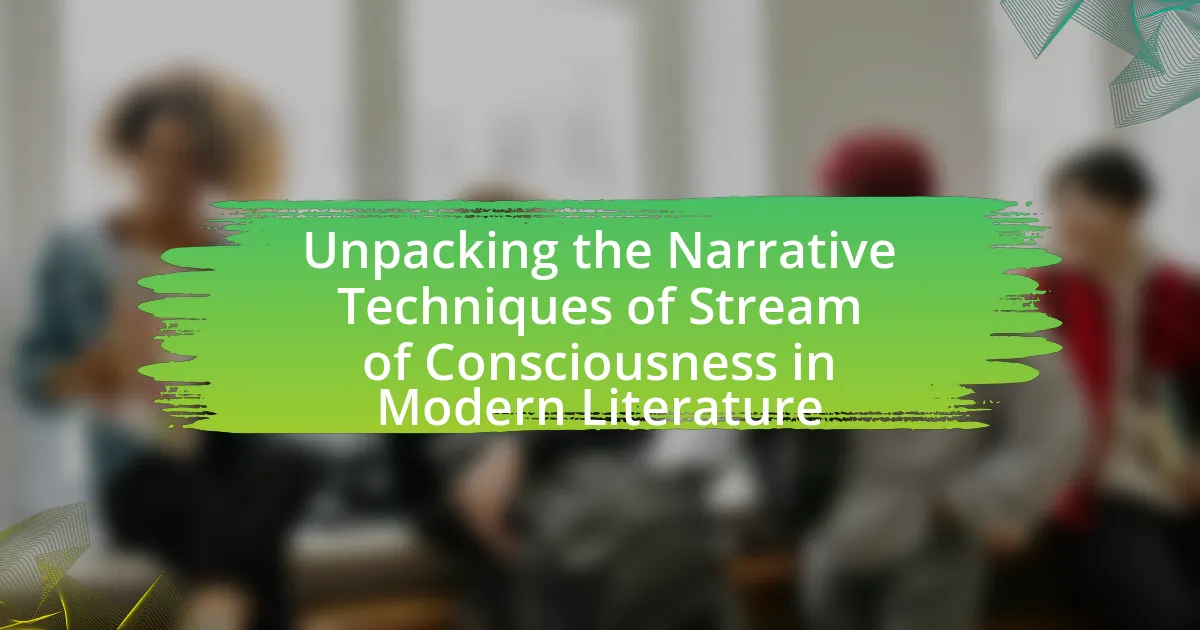Revisiting classic literature through modern adaptations plays a crucial role in making timeless narratives relevant to contemporary audiences. This article explores how adaptations reinterpret classic texts by infusing contemporary themes, altering character portrayals, and addressing current societal issues such as gender roles and social justice. It examines the significance of these adaptations in preserving original narratives while enhancing accessibility and engagement, as well as the challenges and criticisms they face. Additionally, the article highlights the various forms of adaptations, including film, stage, and graphic novels, and discusses best practices for creators to balance fidelity to the original work with creative innovation.

What is the significance of revisiting classic literature in modern times?
Revisiting classic literature in modern times is significant because it allows contemporary audiences to engage with timeless themes and societal issues that remain relevant. Classic works often explore fundamental human experiences such as love, conflict, and morality, which resonate across generations. For instance, adaptations of Shakespeare’s plays continue to be performed and reinterpreted, demonstrating their enduring relevance in addressing themes of power and identity. Furthermore, modern adaptations can provide fresh perspectives, making these works accessible to diverse audiences and encouraging critical discussions about cultural and historical contexts. This process not only preserves the original narratives but also revitalizes them, ensuring their place in contemporary discourse.
How do modern adaptations reinterpret classic narratives?
Modern adaptations reinterpret classic narratives by infusing contemporary themes, diverse perspectives, and updated contexts that resonate with today’s audiences. For instance, adaptations like “The Great Gatsby” in film and television often emphasize issues such as class disparity and the American Dream, reflecting current societal concerns. Additionally, works like “Pride and Prejudice” have been reimagined in various settings, including modern-day adaptations that explore gender roles and social dynamics, showcasing how timeless stories can evolve while retaining their core messages. This approach not only revitalizes interest in classic literature but also allows for critical engagement with its themes in light of modern values and experiences.
What themes are commonly altered in these adaptations?
Commonly altered themes in modern adaptations of classic literature include gender roles, morality, and social class. These adaptations often reframe traditional narratives to reflect contemporary values and issues. For instance, adaptations of works like “Pride and Prejudice” frequently emphasize female empowerment and independence, diverging from the original focus on marriage and social status. Similarly, adaptations of “The Great Gatsby” may highlight themes of wealth disparity and the American Dream’s disillusionment, aligning with current societal concerns about economic inequality. These changes illustrate how adaptations can reshape the thematic landscape to resonate with modern audiences.
How do character portrayals change in modern adaptations?
Character portrayals in modern adaptations often shift to reflect contemporary values and social issues, resulting in more nuanced and diverse representations. For instance, adaptations of classic literature frequently reimagine characters to challenge traditional gender roles, as seen in adaptations of works like “Pride and Prejudice,” where Elizabeth Bennet is portrayed with greater assertiveness and independence compared to earlier versions. Additionally, modern adaptations may introduce characters from underrepresented backgrounds or alter existing characters’ identities to promote inclusivity, such as the casting of actors of different ethnicities in roles originally written for white characters. This evolution in character portrayal aligns with societal movements advocating for equality and representation, demonstrating how adaptations serve as a mirror to current cultural conversations.
Why is it important to adapt classic literature?
Adapting classic literature is important because it allows timeless themes and narratives to resonate with contemporary audiences. Modern adaptations can bridge cultural and generational gaps, making the original works more accessible and relevant. For instance, adaptations of Shakespeare’s plays into modern settings have demonstrated how universal themes of love, power, and betrayal remain pertinent today, thus attracting new audiences who may not engage with the original texts. This relevance is supported by the success of adaptations like “West Side Story,” which reinterprets “Romeo and Juliet” in a contemporary urban context, illustrating that classic stories can evolve while retaining their core messages.
What cultural relevance do these adaptations hold today?
Modern adaptations of classic literature hold significant cultural relevance today as they reflect contemporary societal values and issues, making timeless narratives accessible and relatable to current audiences. These adaptations often address themes such as identity, gender roles, and social justice, which resonate with modern viewers. For instance, adaptations like “The Handmaid’s Tale” and “Pride and Prejudice and Zombies” reinterpret classic texts to explore themes of feminism and empowerment, demonstrating how these stories can evolve to reflect ongoing cultural conversations. Furthermore, the popularity of such adaptations in film and television indicates a collective desire to engage with and critique historical narratives, thereby fostering a deeper understanding of both the past and present.
How do adaptations reflect contemporary societal issues?
Adaptations reflect contemporary societal issues by reinterpreting classic narratives to address current themes such as inequality, identity, and technology. For instance, modern adaptations of works like “The Handmaid’s Tale” highlight issues of women’s rights and authoritarianism, resonating with ongoing discussions about reproductive rights and government control. This relevance is evident in the series’ portrayal of a dystopian society that mirrors real-world political climates, thereby engaging audiences with pressing social concerns. Additionally, adaptations often incorporate diverse perspectives, showcasing marginalized voices and experiences, which aligns with contemporary movements advocating for inclusivity and representation in media.
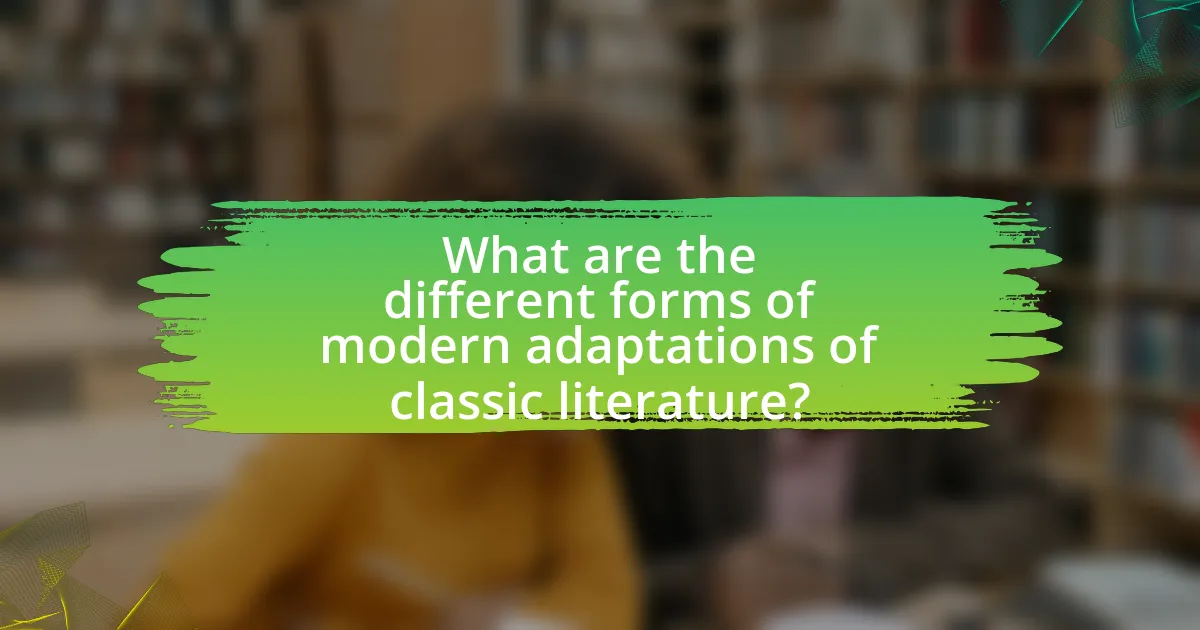
What are the different forms of modern adaptations of classic literature?
Modern adaptations of classic literature take various forms, including film adaptations, stage productions, novels, graphic novels, and television series. Film adaptations reinterpret classic texts for contemporary audiences, often altering settings or character dynamics; for example, the 1996 film “Romeo + Juliet” modernizes Shakespeare’s play while retaining its original dialogue. Stage productions, such as the musical “Hamilton,” reimagine historical narratives through modern music and diverse casting. Novel adaptations, like Jean Rhys’s “Wide Sargasso Sea,” provide backstories or alternative perspectives on classic characters, enriching the original narrative. Graphic novels, such as “The Complete Maus” by Art Spiegelman, visually reinterpret classic stories, making them accessible to new audiences. Television series, like “The Handmaid’s Tale,” adapt classic literature into episodic formats, allowing for deeper character exploration and thematic development. Each of these forms demonstrates how classic literature can be reinterpreted to resonate with contemporary societal issues and cultural contexts.
How do films and television series adapt classic texts?
Films and television series adapt classic texts by reinterpreting the original narratives, characters, and themes to fit contemporary contexts and audience sensibilities. This process often involves altering plotlines, updating settings, or changing character motivations to resonate with modern viewers. For example, adaptations like “Pride and Prejudice” have been reimagined in various forms, including the 2005 film and the 1995 miniseries, each offering unique perspectives while maintaining core elements of Jane Austen’s story. Such adaptations can also introduce new themes, such as feminism or social justice, reflecting current societal issues, thereby making classic literature more accessible and relevant to today’s audiences.
What are some notable examples of successful adaptations?
Notable examples of successful adaptations include “Pride and Prejudice” by Jane Austen, adapted into various films and television series, with the 2005 film starring Keira Knightley receiving critical acclaim and a BAFTA nomination. Another example is “The Great Gatsby,” originally by F. Scott Fitzgerald, which has seen multiple adaptations, with the 2013 film directed by Baz Luhrmann praised for its visual style and fidelity to the novel’s themes. Additionally, “The Handmaid’s Tale,” based on Margaret Atwood’s novel, has been successfully adapted into a television series, winning numerous awards and expanding the narrative’s reach and impact. These adaptations demonstrate how classic literature can be reinterpreted for modern audiences while retaining core themes and messages.
How do visual storytelling techniques enhance the narrative?
Visual storytelling techniques enhance the narrative by providing a multi-sensory experience that deepens audience engagement and understanding. These techniques, such as imagery, color, and composition, allow for the conveyance of emotions and themes that may not be as effectively communicated through text alone. For instance, studies show that visual elements can evoke emotional responses more rapidly than written descriptions, thereby reinforcing the narrative’s impact. Additionally, visual storytelling can simplify complex ideas, making them more accessible to diverse audiences, as evidenced by the success of graphic novels and film adaptations of classic literature, which often attract wider readership and viewership compared to their original texts.
What role do stage adaptations play in revisiting classic literature?
Stage adaptations serve as a vital mechanism for revisiting classic literature by transforming timeless narratives into accessible and engaging performances. These adaptations breathe new life into original texts, allowing contemporary audiences to connect with themes and characters in a modern context. For instance, adaptations of Shakespeare’s works often incorporate current social issues, making the material relevant to today’s viewers. This practice not only revitalizes interest in classic literature but also encourages critical discussions about its themes, thereby enhancing understanding and appreciation. Furthermore, stage adaptations can introduce classic works to those who may not engage with the original texts, expanding the audience base and fostering a deeper cultural dialogue around literary heritage.
How do live performances reinterpret the source material?
Live performances reinterpret the source material by infusing contemporary themes, altering character dynamics, and utilizing innovative staging techniques. For instance, adaptations of classic literature often reflect current societal issues, making the narrative more relatable to modern audiences. A notable example is the adaptation of Shakespeare’s “Romeo and Juliet,” which has been set in various cultural contexts, such as gang rivalries in “West Side Story,” thereby shifting the focus from feuding families to social conflict. Additionally, live performances can modify character portrayals, emphasizing different traits or motivations that resonate with today’s viewers, such as portraying Lady Macbeth as a more complex figure in recent adaptations. These reinterpretations are further enhanced by creative use of technology and multimedia, which can transform the audience’s experience and understanding of the original text.
What unique challenges do stage adaptations face?
Stage adaptations face unique challenges such as the need to condense complex narratives into a limited timeframe while maintaining the essence of the original work. This often requires significant alterations to character development and plot structure, which can lead to the loss of depth and nuance present in the source material. Additionally, stage adaptations must consider the physical limitations of the performance space, which can restrict the portrayal of certain scenes or settings that are easily depicted in literature. For instance, the transition from a novel to a stage play may necessitate the elimination of subplots or characters to fit the runtime, impacting the overall narrative. Furthermore, the adaptation process must navigate the expectations of audiences familiar with the original work, balancing fidelity to the source with creative interpretation to engage viewers effectively.

How do modern adaptations impact the perception of classic literature?
Modern adaptations significantly influence the perception of classic literature by making these works more accessible and relevant to contemporary audiences. By reinterpreting themes, characters, and settings, adaptations often highlight issues such as social justice, gender equality, and cultural diversity, which resonate with today’s societal values. For instance, adaptations like “The Great Gatsby” in various film formats have emphasized the American Dream’s flaws, prompting discussions about wealth inequality. Furthermore, studies show that adaptations can increase readership; for example, the success of the “Pride and Prejudice and Zombies” novel led to a resurgence of interest in Jane Austen’s original work. Thus, modern adaptations not only breathe new life into classic texts but also reshape their meanings and relevance in today’s cultural landscape.
What are the potential benefits of modern adaptations for classic texts?
Modern adaptations of classic texts can enhance accessibility and relevance for contemporary audiences. By updating language, themes, and settings, these adaptations make the original works more relatable and engaging, thereby attracting new readers who might find the original texts daunting or outdated. For example, adaptations like the film “Pride and Prejudice and Zombies” recontextualize Jane Austen’s work, blending genres to appeal to modern sensibilities. Additionally, modern adaptations can introduce diverse perspectives, as seen in adaptations that feature characters from underrepresented backgrounds, thus broadening the narrative scope and enriching the original story. This approach not only revitalizes interest in classic literature but also fosters discussions around its themes in today’s societal context.
How do adaptations attract new audiences to classic literature?
Adaptations attract new audiences to classic literature by reinterpreting timeless themes and characters in contemporary contexts, making them more relatable and accessible. For instance, film and television adaptations often modernize settings or incorporate current social issues, which resonate with younger viewers. A notable example is the 2012 film adaptation of “Les Misérables,” which highlighted themes of social justice and poverty, drawing in audiences who may not have engaged with Victor Hugo’s original 1862 novel. Additionally, adaptations often utilize popular actors and modern storytelling techniques, enhancing viewer engagement and interest in the source material. This approach not only revitalizes classic texts but also encourages exploration of the original works, as evidenced by increased sales and readership following successful adaptations.
What educational value do adaptations provide for students?
Adaptations provide significant educational value for students by enhancing their understanding of classic literature through contemporary contexts. By reinterpreting themes, characters, and narratives, adaptations make complex texts more accessible and relatable, fostering critical thinking and engagement. For instance, adaptations often highlight relevant social issues, allowing students to draw parallels between historical and modern contexts, which can deepen their comprehension and analytical skills. Research indicates that students who engage with adaptations demonstrate improved literary analysis abilities, as they can compare and contrast different interpretations, thereby enriching their overall learning experience.
What criticisms do modern adaptations face?
Modern adaptations face criticisms primarily for altering the original narrative and themes of classic literature. Critics argue that these changes can dilute the essence of the source material, leading to a loss of cultural and historical context. For instance, adaptations may introduce contemporary issues or perspectives that were not present in the original work, which can alienate purists who value fidelity to the text. Additionally, some adaptations are criticized for prioritizing entertainment value over depth, resulting in superficial interpretations that fail to capture the complexity of the original characters and plotlines. This has been observed in various film and television adaptations, where the focus on visual spectacle often overshadows the nuanced storytelling found in the literature.
How do purists react to changes made in adaptations?
Purists typically react negatively to changes made in adaptations, viewing them as distortions of the original work. This reaction stems from a strong attachment to the source material, which purists believe should be preserved in its original form. For instance, adaptations that alter character motivations or plot points often face backlash, as purists argue that such changes undermine the author’s intent and the integrity of the narrative. Historical examples include the criticism faced by film adaptations of classic novels, such as the backlash against the 2012 film adaptation of “Les Misérables,” where purists felt that the musical elements overshadowed the novel’s themes.
What are common pitfalls in adapting classic literature?
Common pitfalls in adapting classic literature include oversimplification of themes, misinterpretation of characters, and neglecting historical context. Oversimplification occurs when complex narratives are reduced to basic plots, losing the depth and nuance that define the original work. Misinterpretation of characters can lead to portrayals that stray significantly from the author’s intentions, altering the audience’s understanding of their motivations and relationships. Neglecting historical context often results in anachronisms that can distort the original message and cultural significance of the text. These pitfalls can diminish the impact of the adaptation and alienate audiences familiar with the source material.
What best practices should creators follow when adapting classic literature?
Creators should prioritize fidelity to the original themes and character motivations when adapting classic literature. This ensures that the essence of the source material is preserved while allowing for contemporary relevance. Additionally, creators should consider the cultural and historical context of the original work, as this can inform modern interpretations and resonate with current audiences. Engaging with diverse perspectives can also enrich adaptations, making them more inclusive and reflective of today’s society. By balancing respect for the original text with innovative storytelling techniques, creators can effectively bridge the gap between classic literature and modern audiences.
How can creators balance fidelity to the original text with creative freedom?
Creators can balance fidelity to the original text with creative freedom by identifying core themes and character motivations while allowing for modern reinterpretations. This approach enables them to honor the essence of the original work, such as the moral dilemmas in Shakespeare’s plays, while adapting dialogue and settings to resonate with contemporary audiences. For instance, adaptations like “West Side Story” maintain the thematic conflict of “Romeo and Juliet” but recontextualize it within a 20th-century urban setting, demonstrating how creators can innovate while respecting the source material.
What strategies can enhance audience engagement with adaptations?
To enhance audience engagement with adaptations, creators can employ interactive storytelling techniques. Interactive storytelling allows audiences to influence the narrative direction, fostering a deeper emotional connection and investment in the story. Research indicates that interactive media can increase user engagement by up to 50%, as audiences feel more involved in the narrative process. Additionally, incorporating multimedia elements, such as social media campaigns and augmented reality experiences, can further immerse audiences in the adaptation, making the experience more dynamic and relatable. These strategies not only attract attention but also encourage discussions and community building around the adaptation, ultimately enhancing overall engagement.
